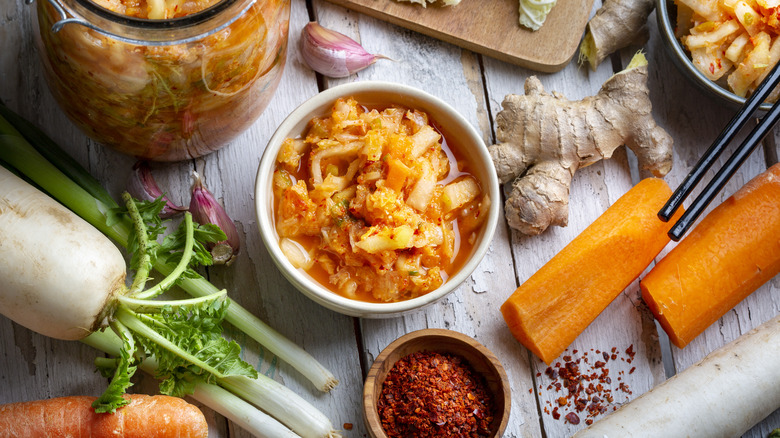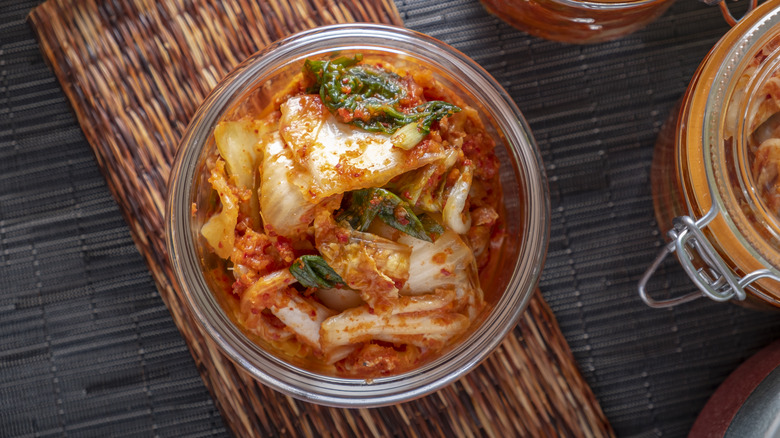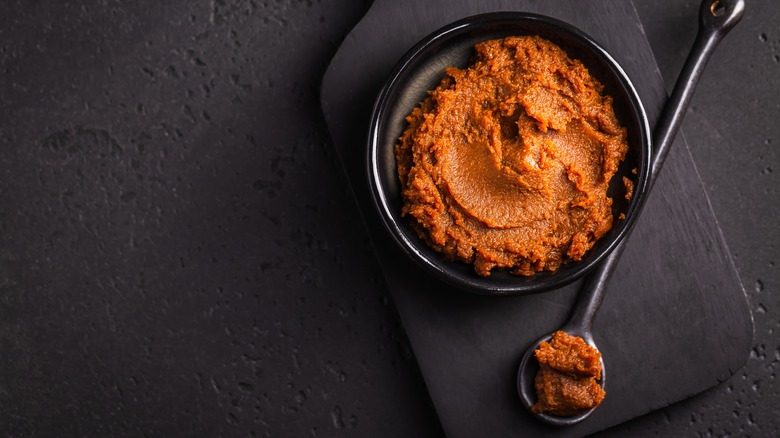The Ingredient Substitute You Need For Vegan Kimchi
You would think that a dish like kimchi, which heavily (and almost exclusively) features vegetables like cabbage, radish, garlic, and ginger (along with red chilies and salt), would necessarily be vegan, but that isn't traditionally the case. In Korea, where kimchi is usually served with every meal, the beloved side salad usually contains jeotgal, a kind of salted, fermented fish seasoning made from everything from shrimp to pollack guts. Pretty much every Westernized kimchi recipe calls for fish sauce, which is close enough. However, if you're vegan, don't be dissuaded from making this marvelous dish at home: Miso paste makes a terrific fish sauce substitute without sacrificing any of its salty, fermented, and umami essentials.
Kimchi was an ingenious solution to the problem of preserving harvested vegetables for upcoming winters, using two foolproof methods: salting and fermentation. What kimchi does for cabbage, scallions, garlic, ginger, and radishes (and much more besides), miso does for soybeans, which are fermented with salt and an aspergillus mold called koji. Subbing miso out for fish sauce when making vegan kimchi is a no-brainer.
Kimchi is a world unto itself
Koreans love their kimchi, producing around 200 different types of the stuff. In addition to Napa cabbage — essential to making the popular baechu kimchi — different versions of kimchi can include mushrooms, Asian pear, pine nuts, or pumpkin. Apart from salt and (usually) spice, the only other kimchi constant is that it's pickled with lactic acid bacteria. After that, the sky's the limit.
Because of all these things, kimchi is a low- or non-fat, low-calorie, high-fiber, vitamin-packed probiotic superfood that you need in your life. And guess what? Miso also happens to be nutrient-rich and great for your gut, packing in even a little protein (three grams per ounce). The only nutritional downside to eating kimchi — whether made with miso paste or not — is its noticeably high salt content.
Kimchi and miso sitting in a tree
The fact is, you can't avoid the heavy use of salt when making kimchi; it's essential to the process of lacto-fermentation. Kimchi's salt brine suppresses the growth of bad bacteria, allowing for the good stuff to flourish. Because it covers the vegetables, it also acts as a barrier against oxidation and its consequence, rot. The essential rule of thumb when making a kimchi brine is that it should contain 2% salt.
Miso paste won't have all the salt you'll need to ferment your kimchi, but it will provide an incredible flavor. Try using red miso — the most robust of the four main types of miso paste — because even it won't overwhelm the balance of the dish. (About a half cup of the stuff is all you'll need for a 20-serving batch.) Fermented for longer than its white or yellow cousins, red miso has a more complex, pungent flavor; perfect for a zingy side of kimchi. Now it's time to get schooled up on gochujang and perfect your recipe!


